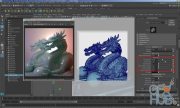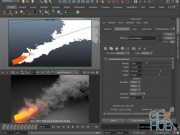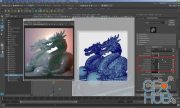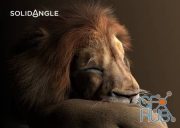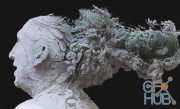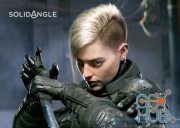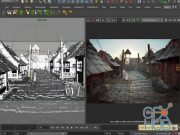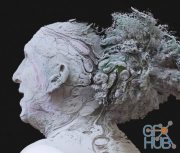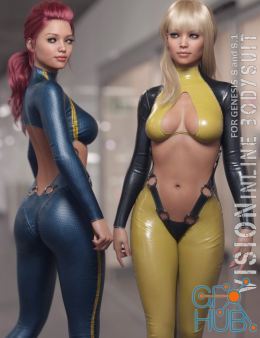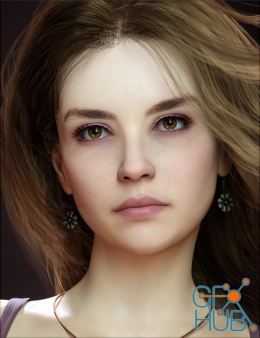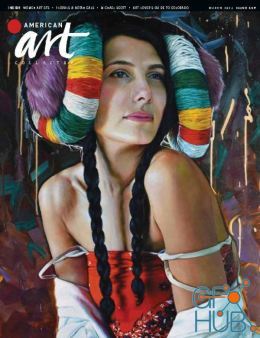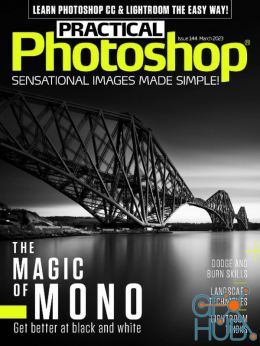Solid Angle Maya To Arnold v3.2.0 for Maya 2017 to 2019 (Win/Mac/Linux)
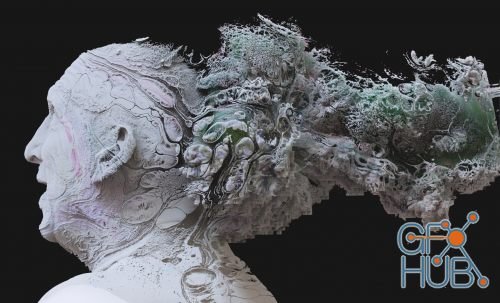
Solid Angle Maya To Arnold v3.2.0 for Maya 2017 to 2019 (Win/Mac/Linux)
Arnold for Maya (or MtoA) provides a bridge to the Arnold renderer from within Maya’s standard interface. MtoA is now shipping with the Arnold 5.0 core.
Changes v3.2.0
GPU Rendering (BETA):
You can now switch between CPU and GPU render devices interactively and expect visually similar results. NVIDIA® GPUs from Turing™ to Maxwell™ architectures are supported, and Arnold will take advantage of multiple GPUs, NVLink™ and NVIDIA® RTX™ hardware accelerated raytracing if available. Note that due to beta status of GPU rendering, a number of features are missing, performance is not final, and use in production is not advised. We plan to gradually improve this in subsequent releases and would appreciate your feedback. For a complete description of requirements, features and caveats, see Getting Started With Arnold GPU.
Improved Sampling:
Improved adaptive sampling: Adaptive sampling is now much more effective and predictable than before.
Improved skydome sampling: Skydome light's sampling has been improved, in particular in darker areas. Note that existing scenes which were adjusted with previous versions of Arnold will now need to lower down the number of light samples for an equivalent result.
Faster sample generation: Scenes with a high number of AA and light samples could take a very long time to start rendering. This is now much faster (some use cases went from 11 minutes to a fraction of a second, before the render starts).
Improved Shading:
Microfacet multiple scattering: The GGX microfacet BSDF used in the standard_surface shader has been improved to account for multiple scattering between the microfacets, which is more physically correct and reduces energy loss on reflection, especially at higher roughness settings. The reflection from rough metals, in particular, will be significantly brighter and more saturated as a result.
Improved randomwalk SSS: A new SSS mode randomwalk_v2 has been added that scatters more accurately and deeply through highly-transparent/optically-thin objects, which produces SSS with more saturated colors around fine surface detail and heavily backlit regions of an object
Smart opaque: When using builtin shaders, Arnold will now automatically set the opaque parameter in the shapes. Setting transparency only in the shaders will now be enough (exceptions are curves / points using min_pixel_width). Custom shaders can support this feature by setting metadatas opacity_term and transparency_term in the shaders.
Improved bump and normal_mapping: bump and normal mapping now correct for non-physical shading normals (eg. extreme values) while preserving detail.
Anisotropy controls for coat in aiStandardSurface
Support for negative "Transmission Extra Roughness" in aiStandardSurface
New aiUvProjection shader allows to do spherical/cubic/ etc.. projections on a surface
Exposing Arnold shaders aiCameraProjection, aiRampRgb, aiRampFloat, aiRgbaToFloat
Visible Lights:
Area Lights and point lights can now be made visible to camera and transmission rays by increasing parameters camera and transmission.
StandIns & gpuCache workflow improvements:
New UI for shader assignments and overrides using Arnold operators: A new UI in Stand-ins and gpuCache allows to introspect nodes, assign shaders to specific elements, override parameters, etc... in a user-friendly way. It will allow to create and edit operators attached to the Stand-in, that will, therefore, be portable across scene references. Check the video showing how to use Operators and assignments with alembic files.
Standins can now load alembic files
Show selected item in the viewport: While introspecting a Stand-in content, selecting items will highlight them in the viewport. Picking in the Arnold RenderView will also select the corresponding item.
New workflow for Standin's proxy geometries in the viewport: A new parameter ignoreGroupNodes will skip all the nodes below the Stand-in hierarchy for rendering. The desired proxy geometries just need to be parented to the Stand-in, and they will only appear in the viewport when this parameter is enabled.
Subdivision creases supported in Alembic
Export Shading trees as MaterialX files:
New menu Export Selection to MaterialX allows exporting the selected shading trees to a materialx document. It's also possible to append several looks to a single mtlx file and then to switch between both in the materialx operator. Geometrie's properties (subdivision settings, etc...) can also be baked to the file.
Operators:
Added option to Export/Import operator graphs: New menu Export Operator Graph allows to export an operator graph to a .ass file (either the selection or the scene's graph). It's then possible to import it back to Maya, or even to another DCC.
New include_graph operator: Includes an operator graph that was previously exported to .ass.
Other:
Improved workflow for motion vectors AOV: new attribute Instantaneous Shutter in the motion blur settings allows getting correct motion vectors AOV while rendering a still image. The shutter range will now be taken into account in the AOV.
Faster .ass file writing: Writing to .ass, especially over Windows networks, can be dramatically faster (up to 51x reported)
Faster OSL UDIM texture reads: Reading UDIM textures in OSL is now much faster (up to 10x reported)
Disabled Swatch rendering by default, to avoid non-necessary excessive slowdowns
Exposing "autobump visibility" in meshes to solve artifacts for objects appearing through sharp reflections/refractions.
Updated to OIIO 2.1.0
Bugfixes:
Fixes on triplanar used for displacement.
Adaptive sampling was being reset to OFF during IPR updates.
Interactivity optimizations when IPR is stopped.
Texture repeat wasn't working with custom UV sets.
Incompatible Changes:
Default specular_roughness in aiStandardSurface is now 0.2. Existing scenes that had left this parameter to its default value might now look different.
Changes in skydome sampling require to lower down the skydome samples on existing scenes for an equivalent result and render times. For the same settings as before, the result will be less noisy but up to 30% longer.
Removed support for NVIDIA Kepler GPUs.
Specular AOV: The sheen component has been removed from the specular AOVs.
Removed SSS on curves.
GPU Rendering (BETA):
You can now switch between CPU and GPU render devices interactively and expect visually similar results. NVIDIA® GPUs from Turing™ to Maxwell™ architectures are supported, and Arnold will take advantage of multiple GPUs, NVLink™ and NVIDIA® RTX™ hardware accelerated raytracing if available. Note that due to beta status of GPU rendering, a number of features are missing, performance is not final, and use in production is not advised. We plan to gradually improve this in subsequent releases and would appreciate your feedback. For a complete description of requirements, features and caveats, see Getting Started With Arnold GPU.
Improved Sampling:
Improved adaptive sampling: Adaptive sampling is now much more effective and predictable than before.
Improved skydome sampling: Skydome light's sampling has been improved, in particular in darker areas. Note that existing scenes which were adjusted with previous versions of Arnold will now need to lower down the number of light samples for an equivalent result.
Faster sample generation: Scenes with a high number of AA and light samples could take a very long time to start rendering. This is now much faster (some use cases went from 11 minutes to a fraction of a second, before the render starts).
Improved Shading:
Microfacet multiple scattering: The GGX microfacet BSDF used in the standard_surface shader has been improved to account for multiple scattering between the microfacets, which is more physically correct and reduces energy loss on reflection, especially at higher roughness settings. The reflection from rough metals, in particular, will be significantly brighter and more saturated as a result.
Improved randomwalk SSS: A new SSS mode randomwalk_v2 has been added that scatters more accurately and deeply through highly-transparent/optically-thin objects, which produces SSS with more saturated colors around fine surface detail and heavily backlit regions of an object
Smart opaque: When using builtin shaders, Arnold will now automatically set the opaque parameter in the shapes. Setting transparency only in the shaders will now be enough (exceptions are curves / points using min_pixel_width). Custom shaders can support this feature by setting metadatas opacity_term and transparency_term in the shaders.
Improved bump and normal_mapping: bump and normal mapping now correct for non-physical shading normals (eg. extreme values) while preserving detail.
Anisotropy controls for coat in aiStandardSurface
Support for negative "Transmission Extra Roughness" in aiStandardSurface
New aiUvProjection shader allows to do spherical/cubic/ etc.. projections on a surface
Exposing Arnold shaders aiCameraProjection, aiRampRgb, aiRampFloat, aiRgbaToFloat
Visible Lights:
Area Lights and point lights can now be made visible to camera and transmission rays by increasing parameters camera and transmission.
StandIns & gpuCache workflow improvements:
New UI for shader assignments and overrides using Arnold operators: A new UI in Stand-ins and gpuCache allows to introspect nodes, assign shaders to specific elements, override parameters, etc... in a user-friendly way. It will allow to create and edit operators attached to the Stand-in, that will, therefore, be portable across scene references. Check the video showing how to use Operators and assignments with alembic files.
Standins can now load alembic files
Show selected item in the viewport: While introspecting a Stand-in content, selecting items will highlight them in the viewport. Picking in the Arnold RenderView will also select the corresponding item.
New workflow for Standin's proxy geometries in the viewport: A new parameter ignoreGroupNodes will skip all the nodes below the Stand-in hierarchy for rendering. The desired proxy geometries just need to be parented to the Stand-in, and they will only appear in the viewport when this parameter is enabled.
Subdivision creases supported in Alembic
Export Shading trees as MaterialX files:
New menu Export Selection to MaterialX allows exporting the selected shading trees to a materialx document. It's also possible to append several looks to a single mtlx file and then to switch between both in the materialx operator. Geometrie's properties (subdivision settings, etc...) can also be baked to the file.
Operators:
Added option to Export/Import operator graphs: New menu Export Operator Graph allows to export an operator graph to a .ass file (either the selection or the scene's graph). It's then possible to import it back to Maya, or even to another DCC.
New include_graph operator: Includes an operator graph that was previously exported to .ass.
Other:
Improved workflow for motion vectors AOV: new attribute Instantaneous Shutter in the motion blur settings allows getting correct motion vectors AOV while rendering a still image. The shutter range will now be taken into account in the AOV.
Faster .ass file writing: Writing to .ass, especially over Windows networks, can be dramatically faster (up to 51x reported)
Faster OSL UDIM texture reads: Reading UDIM textures in OSL is now much faster (up to 10x reported)
Disabled Swatch rendering by default, to avoid non-necessary excessive slowdowns
Exposing "autobump visibility" in meshes to solve artifacts for objects appearing through sharp reflections/refractions.
Updated to OIIO 2.1.0
Bugfixes:
Fixes on triplanar used for displacement.
Adaptive sampling was being reset to OFF during IPR updates.
Interactivity optimizations when IPR is stopped.
Texture repeat wasn't working with custom UV sets.
Incompatible Changes:
Default specular_roughness in aiStandardSurface is now 0.2. Existing scenes that had left this parameter to its default value might now look different.
Changes in skydome sampling require to lower down the skydome samples on existing scenes for an equivalent result and render times. For the same settings as before, the result will be less noisy but up to 30% longer.
Removed support for NVIDIA Kepler GPUs.
Specular AOV: The sheen component has been removed from the specular AOVs.
Removed SSS on curves.
Download links:
Solid.Angle.Maya.To.Arnold.v3.2.0.For.Maya.2017-AMPED.rar
Solid.Angle.Maya.To.Arnold.v3.2.0.For.Maya.2017.LINUX-AMPED.rar
Solid.Angle.Maya.To.Arnold.v3.2.0.For.Maya.2017.MACOSX-AMPED.rar
Solid.Angle.Maya.To.Arnold.v3.2.0.For.Maya.2018-AMPED.rar
Solid.Angle.Maya.To.Arnold.v3.2.0.For.Maya.2018.MACOSX-AMPED.rar
Solid.Angle.Maya.To.Arnold.v3.2.0.For.Maya.2019-AMPED.rar
Solid.Angle.Maya.To.Arnold.v3.2.0.For.Maya.2019.LINUX-AMPED.rar
Solid.Angle.Maya.To.Arnold.v3.2.0.For.Maya.2019.MACOSX-AMPED.rar
Solid.Angle.Maya.To.Arnold.v3.2.0.For.Maya.2017.LINUX-AMPED.rar
Solid.Angle.Maya.To.Arnold.v3.2.0.For.Maya.2017.MACOSX-AMPED.rar
Solid.Angle.Maya.To.Arnold.v3.2.0.For.Maya.2018-AMPED.rar
Solid.Angle.Maya.To.Arnold.v3.2.0.For.Maya.2018.MACOSX-AMPED.rar
Solid.Angle.Maya.To.Arnold.v3.2.0.For.Maya.2019-AMPED.rar
Solid.Angle.Maya.To.Arnold.v3.2.0.For.Maya.2019.LINUX-AMPED.rar
Solid.Angle.Maya.To.Arnold.v3.2.0.For.Maya.2019.MACOSX-AMPED.rar
Solid.Angle.Maya.To.Arnold.v3.2.0.For.Maya.2017-AMPED.rar
Solid.Angle.Maya.To.Arnold.v3.2.0.For.Maya.2017.LINUX-AMPED.rar
Solid.Angle.Maya.To.Arnold.v3.2.0.For.Maya.2017.MACOSX-AMPED.rar
Solid.Angle.Maya.To.Arnold.v3.2.0.For.Maya.2018-AMPED.rar
Solid.Angle.Maya.To.Arnold.v3.2.0.For.Maya.2018.MACOSX-AMPED.rar
Solid.Angle.Maya.To.Arnold.v3.2.0.For.Maya.2019-AMPED.rar
Solid.Angle.Maya.To.Arnold.v3.2.0.For.Maya.2019.LINUX-AMPED.rar
Solid.Angle.Maya.To.Arnold.v3.2.0.For.Maya.2019.MACOSX-AMPED.rar
Solid.Angle.Maya.To.Arnold.v3.2.0.For.Maya.2017.LINUX-AMPED.rar
Solid.Angle.Maya.To.Arnold.v3.2.0.For.Maya.2017.MACOSX-AMPED.rar
Solid.Angle.Maya.To.Arnold.v3.2.0.For.Maya.2018-AMPED.rar
Solid.Angle.Maya.To.Arnold.v3.2.0.For.Maya.2018.MACOSX-AMPED.rar
Solid.Angle.Maya.To.Arnold.v3.2.0.For.Maya.2019-AMPED.rar
Solid.Angle.Maya.To.Arnold.v3.2.0.For.Maya.2019.LINUX-AMPED.rar
Solid.Angle.Maya.To.Arnold.v3.2.0.For.Maya.2019.MACOSX-AMPED.rar
Comments
Add comment
New Daz3D, Poser stuff
New Books, Magazines
 2019-03-21
2019-03-21

 1 053
1 053
 0
0


